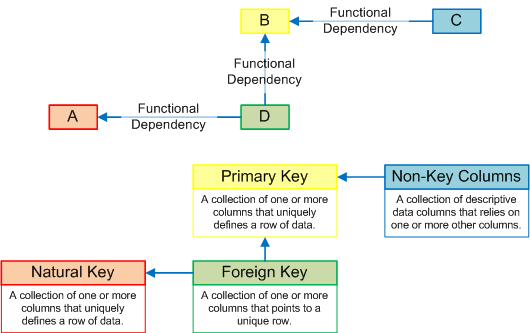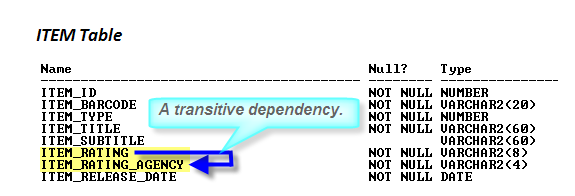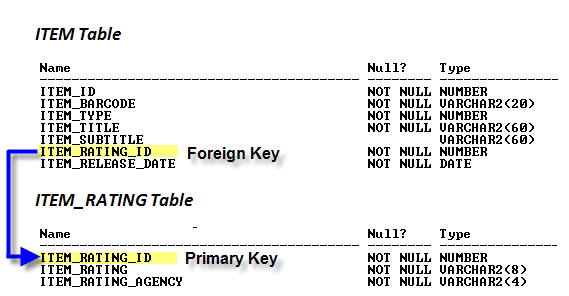3NF Modeling
Week 3: Reading
The following are the reading articles:
3rd Normal Form (3NF)
Learning Outcomes
- Learn how to define and apply Third Normal Form (3NF).
Lesson Materials
Third Normal Form (3NF) exists when a table is already in second normal form and there are no transitive dependencies. A transitive dependency means a non-key column or set of columns are dependent on another column that generally isn’t part of the natural key.
Since all non-key columns should be wholly dependent on the primary key, a transitive dependency exists when a column’s functional dependency routes through another column or set of columns on its way to the primary key. This type of relationship indicates that the there are at least two subjects in a table, and appears as follows conceptually:

You should generally make the column or set of columns that acts as the intermediary column the natural primary key in a new table. The column or columns that had a transitive dependency on the intermediary column should also move to the new table. A foreign key to the new table should replace those columns in the original table, as shown in the following conceptual drawing:

Some exceptions qualify when a transitive dependency doesn’t disqualify a table from being in third normal form. The exceptions are:
- When the transitive dependency is on a column that is part of the natural key.
- When the transitive dependency is on a superkey, like a gender column.
- When the transitive dependency is trivial, which typically means the dependency doesn’t compel the addition of an extra row to a table.
Moreover, you break up the table into two parts to fix any transitive dependencies when moving from second to third normal form. This mirrors what you did to fix partial dependencies when moving from first to second normal form. The only difference between these two exercises is that a partial dependency relates to a part of the primary key, while a transitive dependency relates to a non-key column. The non-key column acts as a portal to the primary key of the second normal form table.
Therefore, third normal form modeling finds and moves columns from a base table when they have a transitive dependence on a column outside the primary key. These columns are generally made into an independent table. A foreign key replaces the columns removed from the base table. The foreign key depends wholly on the primary key of the new table.
Examples & Solutions →
A table that has one or more columns with a transitive dependency on one or more non-key columns isn’t in third normal form.
Problem Example →
You’ll notice that the following example table has a rating that has a transitive dependency on the rating_agency column. This isn’t a partial dependency because the rating_agency column isn’t part of the primary key.

Problem Solution →
You fix this by putting the two columns in a new table, and making the column that is the transitive dependency a foreign key in the base table. Alternatively, you can add a surrogate key to the new table. If you add the surrogate key in the new table, remove both columns from the base table and add a foreign key column that points to the new surrogate key (primary key) column.

Instead of creating the new table with a natural key, the new table has a surrogate key. The old table therefore adds a foreign key of the same name that maps back to the surrogate key of the item_rating table.
Setup Scripts →
While the second script in the prior section lets you create the item table as your starting point, the next script lets you fix the transitive dependency in the previous item table.
-- Conditionally drop the table. BEGIN FOR i IN (SELECT TABLE_NAME FROM user_tables WHERE TABLE_NAME IN ('ITEM','RENTAL')) LOOP EXECUTE IMMEDIATE 'DROP TABLE '||i.table_name||' CASCADE CONSTRAINTS'; END LOOP; END; / -- Create the 2nd normal form tables. CREATE TABLE rental ( rental_id NUMBER CONSTRAINT pk_r1 PRIMARY KEY , item_id NUMBER CONSTRAINT nn_r1 NOT NULL , customer_id NUMBER CONSTRAINT nn_r2 NOT NULL , check_out_date DATE CONSTRAINT nn_r3 NOT NULL , return_date DATE CONSTRAINT nn_r4 NOT NULL); CREATE TABLE item ( item_id NUMBER CONSTRAINT pk_i1 PRIMARY KEY , item_barcode VARCHAR2(20) CONSTRAINT nn_i1 NOT NULL , item_type NUMBER CONSTRAINT nn_i2 NOT NULL , item_title VARCHAR2(60) CONSTRAINT nn_i3 NOT NULL , item_subtitle VARCHAR2(60) , item_rating_id NUMBER CONSTRAINT nn_14 NOT NULL , item_rating VARCHAR2(8) CONSTRAINT nn_i5 NOT NULL , item_rating_agency VARCHAR2(4) CONSTRAINT nn_i6 NOT NULL , item_release_date DATE CONSTRAINT nn_i7 NOT NULL); CREATE TABLE item_rating ( item_rating_id NUMBER CONSTRAINT pk_ir1 PRIMARY KEY , item_rating VARCHAR2(8) CONSTRAINT nn_ir1 NOT NULL , item_rating_agency VARCHAR2(4) CONSTRAINT nn_ir2 NOT NULL); -- Add foreign key constraints. ALTER TABLE rental ADD CONSTRAINT fk_r1 FOREIGN KEY(item_id) REFERENCES item(item_id); ALTER TABLE item ADD CONSTRAINT fk_r1 FOREIGN KEY(item_rating_id) REFERENCES item_rating(item_rating_id); |